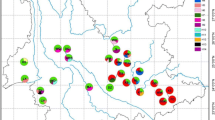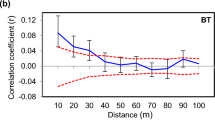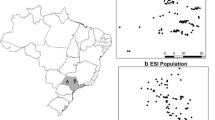Abstract
Genetic diversity is affected by breeding systems, life history traits and the distribution of species. Generally, inbred species with restricted geographic distribution have lower genetic variation compared to common outbreeding plant species. Rhinanthus osiliensis is a narrow endemic growing in calcareous spring fens on the island Saaremaa, Estonia. Presumably the closest congener of R. osiliensis is R. rumelicus, which is widely distributed in Eastern and Central Europe and the Balkan Peninsula. Isozymes were used to describe the mating system, levels of genetic variation and differentiation between the populations of R. osiliensis and R. rumelicus. Genetic diversity was found to be higher in widespread R. rumelicus compared to the endemic R. osiliensis. A significantly higher inbreeding coefficient with a low germination rate indicated substantial autogamy in R. osiliensis, whereas R. rumelicus displayed a mixed mating mode with a moderate inbreeding coefficient and a high germination rate. The low genetic differentiation between R. osiliensis and R. rumelicus confirmed their close affinity and the short evolutionary period of both taxa after the postglacial colonization. Considering the restricted geographic range and inbreeding in populations of R. osiliensis, this species may face a loss of genetic variation in the future.


Similar content being viewed by others
References
Barrett SCH, Kohn JR (1991) Genetic and evolutionary consequences of small population size in plants: implications for conservation. In Falk A, Holsinger K (eds) Genetics and conservation of rare species. Oxford University Press, New York, pp 75–86
Böhme B (2001) Neues über das isolierte Vorkommen von Rhinanthus rumelicus Velen. (Drüsiger Klappertopf) bei Jena. Haussknechtia 8:85–92
Cole C (2003) Genetic variation in rare and common plants. Annual Rev Ecol Syst 34:213–237
Crawford DJ (1985) Electrophoretic data and plant speciation. Syst Bot 10:405–416
Dodd S, Helenurm K (2002) Genetic diversity in Delphinium variegatum (Ranunculaceae): a comparison of two insular endemic subspecies and their widespread mainland relative. Amer J Bot 89:613–622
Dostálek T, Münzbergová Z, Plačková I (2010) Genetic diversity and its effect on fitness in an endangered plant species, Dracocephalum austriacum L. Conservation Genet 11:773–783
Ducarme V, Wesselingh R (2005) Detecting hybridization in mixed populations of Rhinanthus minor and Rhinanthus angustifolius. Folia Geobot 40:151–161
Eichwald K (1960) Rhinanthus osiliensis. In Trass H (ed) Botaanika-alased tööd IV (Publications in botany IV). Tartu Riikliku Ülikooli Toimetised, Tartu, pp 22–30 (in Estonian)
Excoffier L, Smouse PE, Quattro JM (1992) Analysis of molecular variance inferred from metric distances among DNA haplotypes. Application to human mitochondrial DNA restriction sites. Genetics 131:479–491
Felsenstein J (2005) PHYLIP (Phylogeny Inference Package) version 3.68. Distributed by the author. Department of Genome Sciences, University of Washington, Seattle
Foxe JP, Slotte T, Stahl EA, Neuffer B, Hurka H, Wright SI (2009) Recent speciation associated with the evolution of selfing in Capsella. Proc Natl Acad Sci USA 106:5241–5245
Frankham R (1997) Do island populations have less genetic variation than mainland populations? Heredity 78:311–327
Frankham R (1998) Inbreeding and extinction: island populations. Conservation Biol 12:665–675
Galloway LF (2001) The effect of maternal and paternal environments on seed characters in the herbaceous plant Campanula americana (Campanulaceae). Amer J Bot 88:832–840
Gonzales E, Hamrick JL (2005) Distribution of genetic diversity among disjunct populations of the rare forest understory herb, Trillium reliquum. Heredity 95:306–314
Gottlieb LD (1973) Genetic differentiation, sympatric speciation, and the origin of a diploid species of Stephanomeria. Amer J Bot 60:545–553
Gottlieb LD (1977) Electrophoresis evidence and plant systematics. Ann Missouri Bot Garden 64:161–180
Goudet J (2001) FSTAT. A program to estimate and test gene diversities and fixation indeces, Version 2.9.3.2. University of Lausanne, Lausanne. Available at: http://www2.unil.ch/popgen/softwares/fstat.htm (accessed January 2009)
Hamrick JL, Godt MJV (1989) Allozyme diversity in plant species. In Brown AHD, Clegg MT, Kahler AL, Weir BS (eds) Plant population genetics, breeding, and genetic resources. Sinauer Associates Inc., Sunderland, pp 43–63
Hamrick JL, Godt J, Murawski D, Loveless M (1991) Correlations between species traits and allozyme diversity: Implication for conservation biology. In Falk A, Holsinger K (eds) Genetics and conservation of rare species. Oxford University Press, New York, pp 75–86
Helenurm K, West R, Burckhalter S (2005) Allozyme variation in the endangered insular endemic Castilleja grisea. Ann Bot (Oxford) 95:1221–1227
Ingelög T, Andersson R, Tjernberg M (1993) Red data book of the Baltic Region. Lists of threatened vascular plants and vertebrates. Swedish Threatened Species Unit, Institute of Biology, Riga, Uppsala
Jaaska V (1997) Isoenzyme differences between the wild diploid and tetraploid wheats. Genet Resources Crop Evol 44:137–146
Kang U, Chang C-S, Kim YS (2000) Genetic structure and conservation considerations of rare endemic Abeliophyllum distichum Nakai (Oleaceae) in Korea. J Pl Res 113:127–138
Kask M, Lodziņa I, Jankevičienė R (1996) Rhinanthus L. In Kuusk V, Tabaka L, Jankevičienė R (eds) Flora of the Baltic countries II. Eesti Loodusfoto AS, Tartu, pp 337–340
Keller LF, Waller DM (2002) Inbreeding effects in wild populations. Trends Ecol Evol 17:230–241
Kochánková J, Mandák B (2009) How do population genetic parameters affect germination of the heterocarpic species Atriplex tatarica (Amaranthaceae)? Ann Bot (Oxford) 103:1303–1313
Kwak M (1978) Pollination, hybridization and ethological isolation of Rhinanthus minor and R. serotinus (Rhinanthoideae: Scrophulariaceae) by bumblebees (Bombus latr.). Taxon 27 (23):145–158
Kwak MM (1986) Bumblebees and constancy. Acta Bot Neerl 35:39
Lilleleht V (2008) Red Data Book of Estonia. Comission for Nature Conservation of the Estonian Academy of Sciences, Tartu
Matsuki Y, Tateno R, Shibata M, Isagi Y (2008) Pollination efficiencies of flower-visiting insects as determined by direct genetic analysis of pollen origin. Amer J Bot 95:925–930
Meyer SE, Carlson SL (2004) Comparative seed germination biology and seed propagation of eight intermountain species of Indian paintbrush. USDA Forest Serv Proc: RMRS-P-31:125–130
Mora-Vicente S, Caujapé-Castells J, Ma Pérez de Paz J, Febles-Hernández R, Malo JE (2009) Isozyme diversity in some Canarian woody endemisms of the genus Echium L. (Boraginaceae). Pl Syst Evol 279:139–149
Nei M (1978) Estimation of average heterozygosity and genetic distance from a small number of individuals. Genetics 89:583–590
Oja T (1999) Allozyme diversity and interspecific differentiation of the two diploid bromegrass species, Bromus tectorum L. and B. sterilis L. (Poaceae). Pl Biol 1:679–686
Oja T (2005) Isozyme evidence on the genetic diversity, mating system and evolution of Bromus intermedius (Poaceae). Pl Syst Evol 254:199–208
Oja T, Jaaska V, Vislap V (2003) Breeding system, evolution and taxonomy of Bromus arvensis, B. japonicus and B. squarrosus (Poaceae). Pl Syst Evol 242:101–117
Oostermeijer JGB, van Eijck MW, van Leeuwen NC, den Nijs JCM (1995) Analysis of the relationship between allozyme heterozygosity and fitness in the rare Gentiana pneumonanthe L. J Evol Biol 8:739–759
Peakall R, Smouse PE (2006) GENALEX 6: genetic analysis in Excel. Population genetic software for teaching and research. Molec Ecol Notes 6:288–295
Rambaut A (2008) FigTree, ver 1.2.2. Institute of Evolutionary Biology, University of Edinburg. Available at: http://tree.bio.ed.ac.uk/software/figtree/ (accessed February 2009)
Reed D, Frankham R (2003) Correlation between fitness and genetic diversity. Conservation Biol 17:230–237
Reier Ü (2010) Genus Rhinanthus L. In Leht M (ed) Eesti taimede määraja (Field guide of Estonian plants). EMÜ, Eesti Loodusfoto, Tartu, pp 251–252 (in Estonian)
Reitalu M (2003) Rhinanthus rumelicus Velen. subsp. osiliensis Ronniger & Saarsoo. In Ryttäri T, Kukk Ü, Kull T, Jäkäläniemi A, Reitalu M (eds) Monitoring of threatened vascular plants in Estonia and Finland – methods and experiences. Finnish Environment Institute, Helsinki, pp 48–53
Ronniger K (1934) Auffindung einer neuen Rasse des Rhinanthus rumelicus Vel. auf der Insel Ösel (Estland). Feddes Repert XXXV:97–99
Saarsoo B (1933) Uus robiheina liik Alectrolophus rumelicus (Velen.) Borbás Eestis (New species in Estonian flora: Alectrolophus rumelicus (Velen.) Borbás). Loodusvaatleja 6:187–188 (in Estonian)
Saville NM, Dramstad WE, Fry GLA, Corbet SA (1997) Bumblebee movement in a fragmented agricultural landscape. Agric Ecosyst Environm 61(2–3):145–154
Segarra-Moragues JG, Catalán P (2002) Low allozyme variability in the critically endangered Borderea chouardii and in its congener Borderea pyrenaica (Dioscoreaceae), two paleoendemic relicts from the Central Pyrenees. Int J Pl Sci 163:159–166
Soó R, Webb D (1972) Rhinanthus L. In Tutin T, Heywood V, Burges N, Valentine D, Moore D (eds) Flora Europaea 3. Cambridge University Press, Cambrige, pp 276–280
StatSoft, Inc. (2004) STATISTICA (data analysis software system), version 7. Available at: http://www.statsoft.com
Tavakoli Kakhki HR, Kazemi M, Tavakoli H (2008) Analysis of seed size effect on seedling characteristics of different types of wheat (Triticum aestivum L.) cultivars. Asian J Pl Sci 7:666–671
Ter Borg S (2005) Dormancy and germination of six Rhinanthus species in relation to climate. Folia Geobot 40:243–260
Thiele J, Hansen T, Siegismund HR, Hauser TP (2010) Genetic variation of inbreeding depression among floral and fitness traits in Silene nutans. Heredity 104:52–60
Utelli AB, Roy BA (2000) Pollinator abundance and behabior on Aconitum lycoctonum (Ranunculaceae): An analysis of the quantity and quality components of pollination. Oikos 89:461–470
Vasilchenko IT (1955) Rhinanthus L. In Shishkin BK, Bobrov EG (eds) Flora URSS 22. Academiae Scientiarum URSS, Moscow, pp 659–685
Weir BS, Cockerham CC (1984) Estimating F-statistics for the analysis of population structure. Evolution 38:1358–1370
Wendel J, Weeden N (1989) Visualization and interpretation of plant isozymes. In Soltis D, Soltis P (eds) Isozymes in plant biology. Dioscorides Press, Portland, Oregon, pp 5–45
Westbury DB (2004) Rhinanthus minor L. Biological flora of the British Isles. J Ecol 92:906–927
Acknowledgements
We thank M. Reitalu for information and for the permission to collect samples and Ü. Aarna for laboratory assistance and seed germination. We also thank V. Jaaska for providing valuable comments and M. Mürk for editing the English version of the manuscript. This work was supported by the European Regional Development Fund (Center of Excellence FIBIR) and the Estonian Science Foundation Grant 7544.
Author information
Authors and Affiliations
Corresponding author
Rights and permissions
About this article
Cite this article
Talve, T., Orav, K., Angelov, G. et al. Comparative Study of Seed Germination and Genetic Variation of Rare Endemic Rhinanthus osiliensis and Related Widespread Congener R. rumelicus (Orobanchaceae). Folia Geobot 47, 1–15 (2012). https://doi.org/10.1007/s12224-011-9105-x
Received:
Revised:
Accepted:
Published:
Issue Date:
DOI: https://doi.org/10.1007/s12224-011-9105-x




